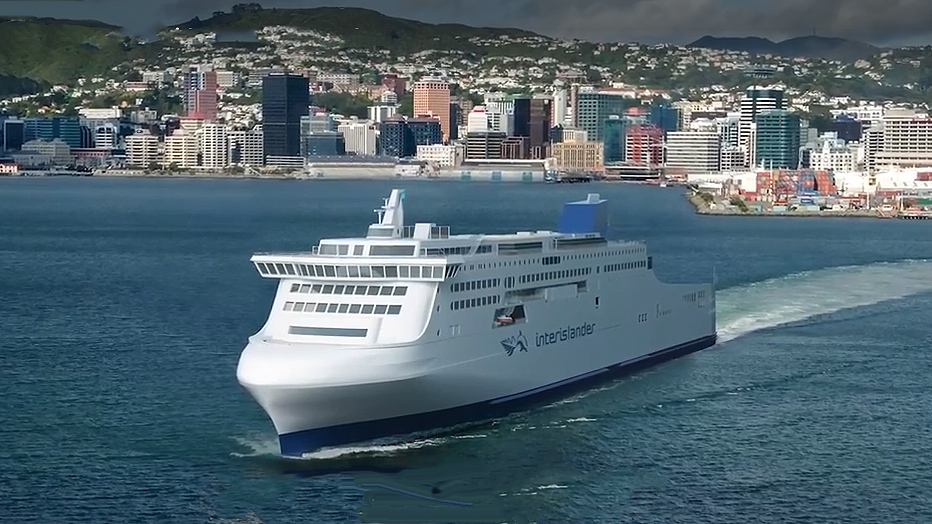
By Brendon Harre*
In December the newly elected government cancelled its support for KiwiRail’s iReX (Interisland Resiliency Connection) project due to its excessive cost, forcing KiwiRail to cancel its build order for the mega-ferries that would have delivered new ships in the beginning of 2026.
This has proved to be controversial because it has implications for the viability of the entire rail network. Dr Bryce Edwards aggregates the various perspectives in an excellent summative article. From that article it can be seen that there has been no public discussion of simplifying the design of the port upgrades to cut costs to an affordable level.
This discussion piece will make the case that taking a minimum viable design approach could have enabled the mega-ferries project to be progressed.
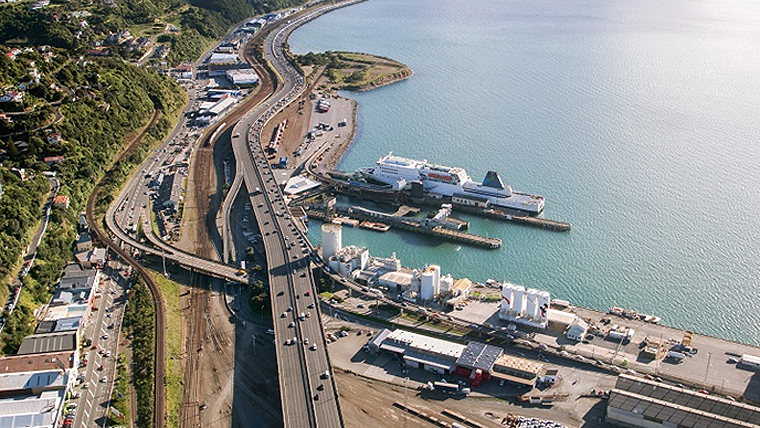
KiwiRail’s current Kaiwharawhara port terminal
The Finance Minister Nicola Willis has said New Zealand should consider Toyota Corolla ships instead of Ferraris for KiwiRail’s interisland shipping. This is understandable because the iReX project had ballooned in cost to over $3 bln.
Yet the new ferries were less than 20% of the iReX cost and had a fixed contract so they were not the direct source of the cost escalation. The thinking seems to be the two larger ships that were to replace KiwiRail’s three smaller ships would need larger loading yards, which explains the escalated cost for the port upgrades.
Yet, there hasn’t been a public examination if this premise is true. What if New Zealand should have considered Toyota ports rather than Toyota ferries?
What if the port upgrades were over-engineered? What if they included unnecessary design features?
At first glance the port upgrades in Wellington and Picton have an extraordinary cost compared to other Wellington infrastructure. To my mind this should have raised eyebrows.

The red circle is the location of Kaiwharawhara Port where the port facilities in Wellington were to be upgraded for new ferries. The red line is the Transmission Gully Motorway.
Upgrading the port facilities in Wellington and Picton escalated in price to $2.5 billion by time the project was cancelled and threatened to escalate further. This is double the cost of the nearby Transmission Gully motorway! It is surprising that upgrading port loading facilities could be more expensive than 27km of motorway construction. A quick look at the above map shows the port upgrades should be significantly smaller projects.
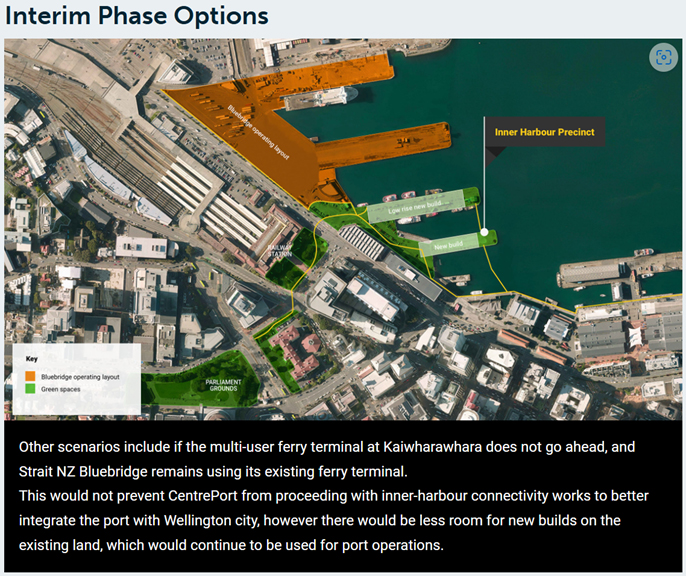
Wellington’s CentrePort has a interim plan if the new multi-user port at Kaiwharawhara is cancelled. Perhaps, KiwiRail should have prepared a similar contingency plan.
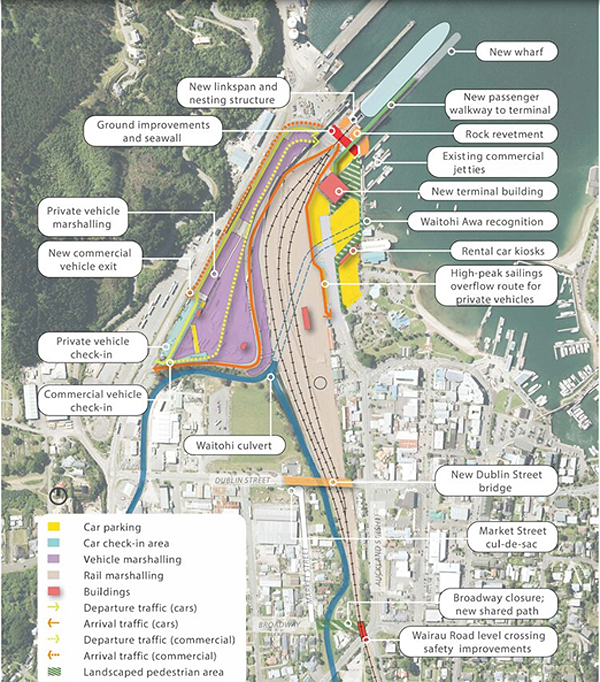
The Picton port upgrade is mainly a renovation of its existing services. There is a extended new wharf, some ground improvements, and a new seawall around the docking area, but no major land reclamation or expansion of the ports footprint.
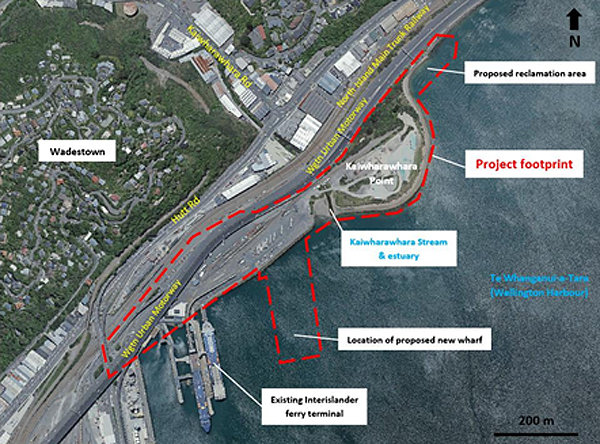
Whereas in Wellington there would have been a significant expansion of port land area at Kaiwharawhara, some of which included land reclamation. Basically, in the above consent application, everything north of Kaiwharawhara stream and estuary is an expansion of the ports footprint.
A large reason for this expansion was the design spec for the Wellington Port upgrade to be a combined KiwiRail and Bluebridge ‘multi-user’ facility. So Kaiwharawhara had to accommodate new loading yards and a new wharf for Bluebridge as well as facilities for KiwiRail’s new mega-ferries. This would be a significant increase in the ports footprint, about a doubling of the required land area.
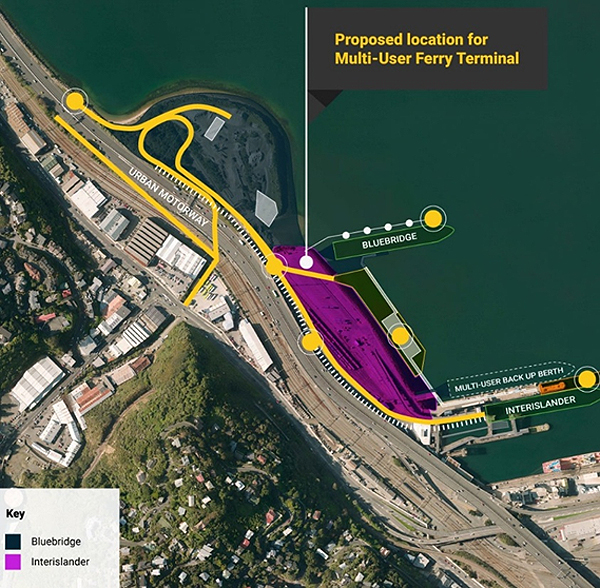
Yet this specification is not strictly necessary. CentrePort has a contingency plan for KiwiRail and Bluebridge to stay in their current separate locations.
If Bluebridge were to stay, could KiwiRail then just upgrade Kaiwharawhara on its existing footprint as a minimum viable solution? The savings could be significant. Pilings for instance were to be 70m deep due to the earthquake risk. Also expanding past Kaiwharawhara stream and estuary meant raising the site by 1 metre due to the flooding risk. The cost for earthquake strengthening, flood protection, land reclamation and a second wharf for Bluebridge must have been significant, the seismic risk alone was a $250 million cost.
A minimum viable solution would not be the perfect 100-year resiliency project that iReX attempted to be and it certainly wouldn’t allow CentrePort to redesign as much of the inner harbour for non-industrial purposes as it wants. But maybe the perfect was the enemy of the good? Because the iReX project was too expensive and therefore not viable, this has exposed New Zealand to other risks.
For instance Gary Taylor the CEO of the Environment Defence Society writes.
“It’s vital for our future emissions profile that we retain rail links across the country. Having rail-enabled ferries is part of that. It would be tragic if we lost that capacity, especially as we are transitioning to a low carbon economy and transport network. As rail technologies evolve, our interisland connections must be compatible with that modality. Ferries that can only carry trucks are 20th century solutions and that, unfortunately, may be where we are headed.”
Also KiwiRail’s three existing ships are between 26 and 29 years old and their service life is 30 years. There have been several near misses, where these ships have temporarily lost power, or their steering has malfunctioned. Any replacement new ships are at a minimum 4 or 5 years away because they will need to be re-ordered with new design specs. Purchasing second hand truck-only ships has been done in the past but is reliant on what is internationally available, which currently is limited.
Purchasing new smaller ferries will cost more than the cancelled ferries because of significant post-covid price inflation. Also cancelling the $550m mega-ferries may have incurred contract break fees of $300m or more. The cost of three smaller ships and the contract break fee will likely exceed $1 bln for a lower specification outcome. Also some sort of upgrade to the 60 year old port and terminal facilities will still be necessary. This cost may be similar to what a minimum viable design for the mega ferries could have been.
The freight carried across the Cook Straight has an annual value of about $15 bln. Both the North and South Islands are growing (interestingly since 2018 the South Island population has grown faster) so the volume of trade should be growing.
If there is a disaster with KiwiRail’s current ships due to their old age not only will it threaten life and limb, it will impact on New Zealand’s cost-of-living, especially in the South Island. It will add a bottleneck to our already lengthy supply lines.
Even if disaster is averted, only having a truck freight connection between the islands has the potential to limit capacity and competition.
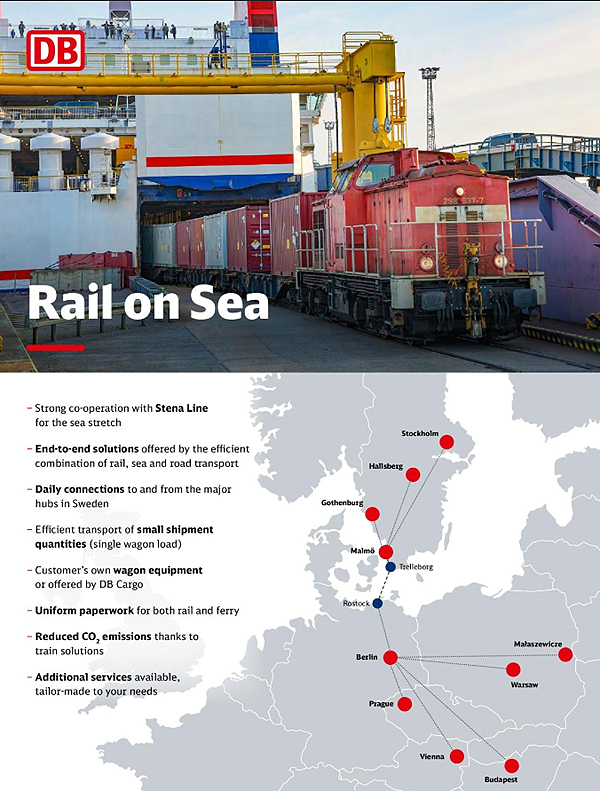
Rail enabled ships as the above picture illustrates are not unusual overseas. I recently took a train trip from Stockholm to Copenhagen to Berlin using a longer non-ferry route than the one depicted above. This is informative because despite there being an alternative route available, rail enabled shipping is a competitive option. Only in the 2030’s will the shipping routes connecting Denmark and Southern Sweden with Germany be cancelled. This is because the Fehmarn rail and road tunnel that is currently under construction will provide a faster, safer, more reliable, and higher capacity alternative.
As things stand New Zealand doesn’t have anything positive like this to look forward to with its interisland transport connection.
It has been suggested that KiwiRail misread the room after the change in government, that it should have been aware of the increased importance of fiscal constraint.
Perhaps if it had taken a minimal viable solution approach it would have made more progress. This could have helped KiwiRail and the country. Is this the real lesson of the sorry mega-ferry upgrade saga?
33 Comments
It is going to be fun to witness this slow motion train wreck, that now seems unavoidable over the next 5 years.
It was folly to cancel the ferries, only the infrastructure plans needed review while alternatives were formulated.
The now cancelled ferries now look like a bargain.
Nats are playing the long game - if we get rid of rail, there can't be any more train wrecks at any speed.
Funny how the wellington works was to include a new Bluebridge terminal was never mentioned by the nats. Can't have free infrastructure for private enterprise mentioned. somebody might then mention that heavy road transport is not paying a fair portion of the roading costs.
They are now looking t the Stena ferries , almost as big as the Irex ferries , but one vital difference . They are not rall enabled. A must for National's donor payback.
I've been playing on Google earth, with an alternative proposal for a Wellington terminal for rail.
That is to have the kiwirail ferry terminal where it is , demolish the old Kaiwharawhara railway station platforms , and have a couple of rail sidings there , enough for 2 strings of wagons each , to be loaded onto the ferry.there is room for a double track connection under the motorway. The Kiwirail signal depot could be moved to provide road access to this area , the cars and track traffic should have enough room ferry side where the existing rail sidings are.
This would allow trains to come straight off the main Trunk onto the Ferry yard, avoiding the trek into the main Wellington rail yard , and back to the ferry terminal .
I would also build a longer rail yard at Porirua, where the 4 strings could be assembled into one train , and off to the new rail terminal at Palmerston North. This could save up to an hour , making rail more competitive with road. And provide some buffer in peak hour commute times.
It might also be a good opportunity to reconsider the ferry service in the light of national productivity - if the South Island terminal got moved to Port Underwood, the trip time drops to about 90 minutes from 3.5 hours as you don't have to cruise through the Sounds at 12 knots.
How long would it take to recuperate the costs of the new port, train line and road?
EDIT: Some years ago (2011), Clifford Bay was mooted as it was near the train line and Highway 1, but from memory that got squelched by the howls of protest from Picton - and it looked like national productivity was second to political considerations.
The cost at the time was budgeted at $200 million. A veritable bargain :-( https://www.stuff.co.nz/business/4976977/Ferry-setting-sail-for-Cliffor…
The time saving benefits would be massive compared to the RoNS motorway projects. The cost was only $525 when it was investigated by the John Key government. Yet National cancelled the project in 2013.
https://www.greaterauckland.org.nz/2013/11/15/clifford-bay-decision-rai…
Reading that article is actually a bit depressing: imagine how much more productive we'd be with that network even partially completed.
And importantly , it could provide redundancy, If Picton is kept as a minor route.
Likewise Wanganui - Nelson would shorten the overall trip from auckland considerably.
Port Underwood is a curious omission , i can't find any study ever into using it as a ferry port. There are some fairly gnarly hills between it and Blenheim, but nothing impossible.
My memory may be playing tricks - Clifford Bay was mooted in 2011 as it was close to rail and HW 1 - https://www.stuff.co.nz/business/4976977/Ferry-setting-sail-for-Cliffor… - but I'm sure there was a proposal for Port Underwood at some point.
You would think it must have been considered, I haven't been able to find any reference to it . But I'm finding the search engines nowhere as good as they used to be for this kind of stuff. if its not on a wiki page , it doesnt exist apparently.
The National Party in 1960 canceled the Nelson to Blenheim railway line that the previous Labour government had started construction on. on https://en.m.wikipedia.org/wiki/Nelson_railway_proposals
If that had gone ahead then an alternative freight shipping route between New Plymouth and Nelson might have been viable. This would have provided a resilency benefit for the risk that a Wellington earthquake destroys interislander transport connections.
And then there is the small problem of a lack of locomotive overhaul capacity in the South Island. All locomotives are overhauled in the Hutt workshops. How do they get there if ferries are not rail capable? Hillside in Dunedin is a wagon only facility now and to equip it for locomotive overhaul will cost more than Willis thinks she is saving. The capability to transfer locomotives and rolling stock by sea - as it was done in the past - in NZ is now gone. No ships in NZ with the necessary lifting capability. We will have to charter heavy lift ships from somewhere in Asia for this capacity. Looks like the thin end of the wedge for South Island rail.
Now if the trucking companies would invest in rail wagons and run them on the rail network the tune might be different. Anybody can run locomotives and rolling stock on the network if the rail charges are paid and the equipment used meets the regulatory standards. The vintage rail guys don't have this problem. Airlines don't seem to have this problem either with airways charges and meeting regulatory standards. Yet the trucking lobby continually whinges it is short on drivers and immigrant drivers will need to be sourced. Shows the short term planning by politicians and lobbyists.The fat controller needs to do better.
They would have to load it on a multi wheeled low loader truck to go on the road ferry , at 120 tonnes or so , not cheap , but doable.
Its pretty clear the plan is to screw rail.
To be fair to National , the treasury and ministry of Transport reports to them consider nothing but the straight economics. But still , its either rookie mistake from Willis , or pure payback for their road transport donors.
Rail capacity on the current rail ferry is 27 wagons x 2 sailings daily (SI return probably mainly emptys). Rail is negligible volume of capital & operationally expensive redundant pre containerised double handling technology unsuited to modern supply chains (unless you're a west coast coal or an oz outback ore mine train)
The rail traffic is almost all containers, the current ferry capacity constraints the whole auck - chch corridor.
Yes containers on flatbeds however unecessary double handling so unsuitable for modern supply chains
Better tell the Americans, they run 200 container doublestacks right across the country.
Is it maybe time to contract out the service to an operator other than Kiwirail - with more experience and a newer fleet available?
That said, I wonder what it would cost to get across the strait - and I'm kind of hanging out for these electric hydrofoils: I don't care if it's twice the price; they're new, fast and smooth. https://www.rnz.co.nz/national/programmes/ninetonoon/audio/2018805997/s…
Kiwirail have been running the ferries for over 50 years , there is no one more experienced???
Experienced in running a small operation in New Zealand - but they are operating outside their core business, in a tiny market, with no competition for the rail freight, a long way from the rest of the world's new ideas, while being chronically underfunded and trying to cope with politicized decision making that makes their operations even harder.
We need an external vendor with new ideas who will make commercial decisions and can supply up-to-date vessels.
Or we could properly fund KiwiRail and seriously upgrade the rail network, extend electrification, etc.
All good until you hit something with the foil (slash, whale. swimmer, recently fired public servants)
Toyota Corolla?
And yet they run them across the English Channel, one of the busiest pieces of water anywhere - and some of the planned versions are startling. https://www.hydrofoiling.org/hydrofoil-ferry-english-channel/ Including the NZ Seaglider (not technically a ship, but runs on the water).
the problem with moving the destination up the north island is tourism, the reason wellington is favoured is so tourists will make their way down the NI and spend money on the way, if the port was moved to Wanganui or new Plymouth they would just go as far as Taupo then turn off. also, whilst boosting nelson and the SI west coast it would reduce tourism in picton Blenheim and Kaikoura,
I do wonder if the cost of the ferries isn't the real problem but what the price of a ticket will be when they are replaced.
Depreciating the assets could well be in the hundred of millions for several years.Divided by a million passengers does this mean the prices need to go up but a couple of hundred dollars?
Its all sh**ts and giggles watching construction costs go through the roof for houses until the pollies realise these same inefficiencies whack us when upgrading infrastructure.
Does anyone know what the prices will be for travel on the new ferries?
I think travel and freight costs will be reflective of the degree of importance government places on our economic development as a country, rather than for their niche constituency groups.
A lot of grown up countries subsidize public goods like the inter-island link, so not hopeful.
A point someone made in another forum , the new ferries were designed to handle pretty much anything the Cook Strait could throw at them . The savings over cancelled services now would be significant, but they also point out the emergency evacuation potential in an extreme weather event for Picton or Wellington. Both have limited road egress, though Wellingtons options have improved with the Transmission gully motorway.
"...the new ferries were designed to handle pretty much anything the Cook Strait could throw at them"
Also "designed" (too long) to use the Tory Channel entrance & turn in Picton Harbour (had to turn in QC/Shakespeare bay & reverse in). Wake issues may also inhibit speed through sounds.
the build got hijacked by the councils and port authority in both places, a lot of the cost for the build was moving the port in wellington and of new bridges etc in picton. if the build of the facilities was done by the owners of those facilities not by kiwirail even with government help the options and pricing would have been much much less. the argument should have been right from word go who owns the terminals and who funds the build.
air New Zealand does not own Auckland airport or any airport, shipping lines do not own ports
Yes , I find it bizarre that Kiwirail was paying to build a Terminal for BlueBridge. Maybe on the grounds of fair competition???.
Kiwirail was borrowing money on its own commercially , to pay for the actual ferries. The same as bluebridge would.
The parent company that owns Bluebridge Cook Strait Ferry has been sold to Morgan Stanley for over half a billion. The parent company of Bluebridge Cook Strait Ferries has been sold by its Australian owner CPE Capital to Morgan Stanley Infrastructure Partners, the Australian Financial Review reports.22 Dec 2021

We welcome your comments below. If you are not already registered, please register to comment.
Remember we welcome robust, respectful and insightful debate. We don't welcome abusive or defamatory comments and will de-register those repeatedly making such comments. Our current comment policy is here.